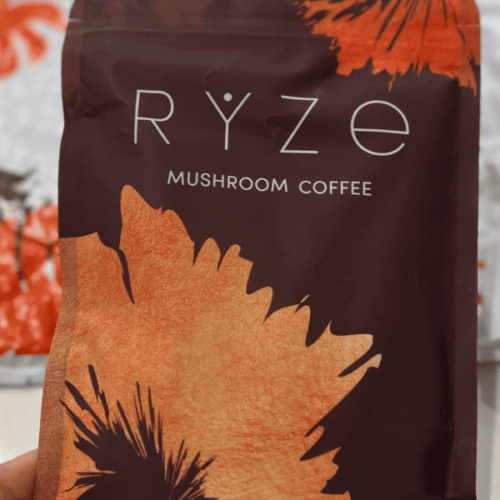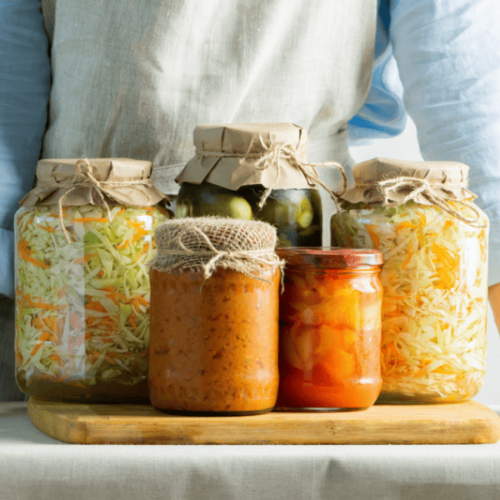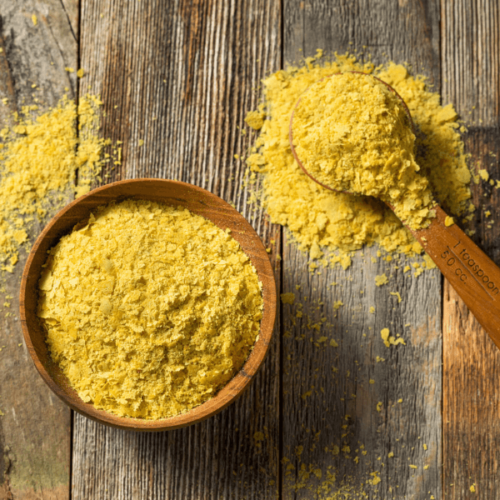Do you want to know how to make goat milk kefir at home? Perfect. You have come to the right place.
I started getting interested in making my own Kefir when I learned more about the positive link between fermented foods and gut health. Not only is Kefir loaded with 61 strains of beneficial bacteria, but it is also linked to helping fight cancer (so it obviously got my attention!)
Store-bought kefir can be expensive and may contain unwanted additives. Making your own goat milk kefir allows you to control the ingredients and save money, but many people don't know where to start.
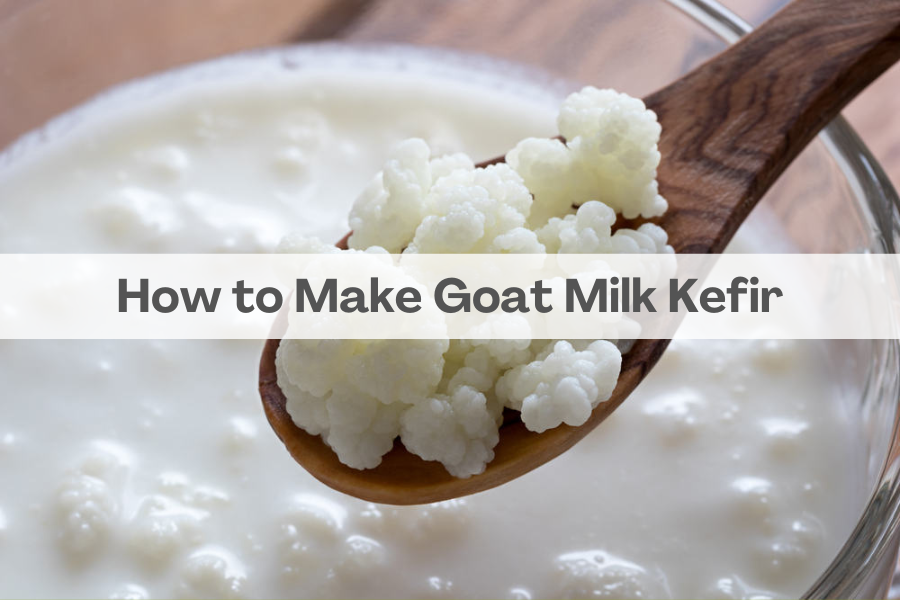
Goat milk kefir is a probiotic-rich fermented drink with numerous health benefits, but the process of making it from scratch using kefir grains and fresh goat milk can seem intimidating if you've never done it before. Without clear instructions, it's hard to know the right ratio of kefir grains to milk, how long to ferment it, and how to store and care for your kefir grains between batches.
In this step-by-step tutorial, you'll learn exactly how to make goat milk kefir at home using just a few simple ingredients. We'll walk you through the entire process from start to finish, including how much milk and kefir grains to use, the optimal fermentation time, how to strain out the grains, and tips for flavoring and storing your finished kefir.
With a little know-how, you'll be whipping up batches of creamy, tangy, probiotic-packed goat milk kefir in your own kitchen in no time! Let's get started.
This blog post is all about "How to Make Goat Milk Kefir".
Key Takeaways:
- Goat milk kefir is a probiotic-rich fermented drink that can be easily made at home using milk kefir grains and offers numerous health benefits, including improved digestion and boosted immunity.
- To make goat milk kefir, combine milk kefir grains with fresh goat milk in a clean glass jar, cover, and allow to ferment at room temperature for 24-48 hours while avoiding common mistakes like using metal utensils or improper storage of grains.
- Kefir can be enjoyed in various ways, such as on its own, in smoothies, dressings, dips, baked goods, and marinades, and experimenting with different types of kefir cultures like water kefir, coconut milk kefir, and soy milk kefir can offer new and delicious ways to incorporate probiotics into your diet.
What is Kefir?
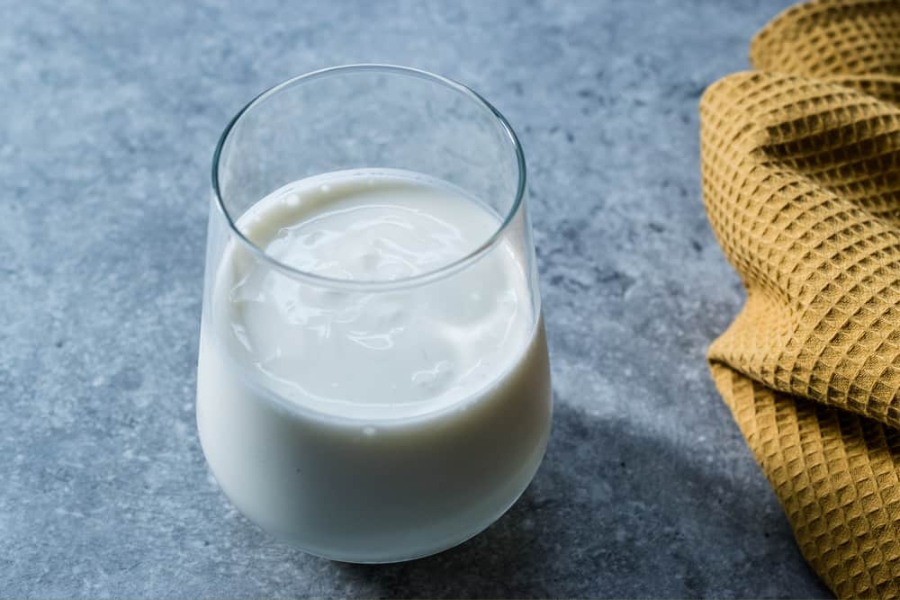
Kefir is a nutritious and delicious fermented milk drink that has been gaining popularity worldwide due to its numerous health benefits and ease of preparation.
Making kefir at home is a simple and rewarding process. The two main ingredients required are milk and milk kefir grains. The kefir grains are added to the milk and allowed to ferment at room temperature for 24-48 hours. During this time, the grains feed on the natural sugars in the milk, transforming it into a probiotic-rich beverage with a slightly gelatinous texture. The fermentation process also breaks down the lactose in the milk, making kefir a great option for those who are lactose intolerant.
One of the most remarkable aspects is the incredible health benefits of kefir. The probiotics in kefir help to restore balance to the digestive system, promoting better gut health and improved digestion. These beneficial bacteria also support the immune system, helping to protect the body against harmful pathogens. Kefir is also rich in vitamins and minerals, including calcium, magnesium, and vitamin K2, which are essential for strong bones and overall wellness.
As more people discover the joys and benefits of homemade kefir, this ancient fermented drink is experiencing a resurgence in popularity. Whether you are a fermentation enthusiast or simply looking for a delicious and nutritious way to support your health, making kefir at home is a rewarding and enjoyable experience that is well worth the effort.
Kefir vs. Yogurt
While kefir and yogurt are both fermented dairy products that contain beneficial probiotics, there are some key differences between the two. Yogurt is made by fermenting milk with specific strains of bacteria, primarily Lactobacillus bulgaricus and Streptococcus thermophilus. These bacteria consume the milk's natural sugars, producing lactic acid and giving yogurt its distinctive tangy flavor and thick, creamy texture.
On the other hand, kefir is made using milk kefir grains, which are a complex mixture of bacteria and yeast that work together to ferment the milk. This symbiotic culture contains a much wider variety of beneficial microorganisms compared to yogurt, including Lactobacillus, Bifidobacterium, Streptococcus, and Saccharomyces. As a result, homemade kefir typically offers a more diverse array of probiotics, which can provide a broader range of health benefits.
Another difference between kefir and yogurt lies in their consistency and taste. Yogurt tends to be thicker and creamier than kefir, with a milder, less tangy flavor. Kefir, on the other hand, has a thinner consistency and a more pronounced, slightly effervescent taste due to the action of the yeast in the milk kefir grains. Some people describe the flavor of this probiotic-rich fermented drink as a cross between yogurt and buttermilk, with a refreshing hint of natural carbonation.
Ultimately, both kefir and yogurt can be excellent sources of probiotics and make delicious, nutritious additions to a healthy diet. However, if you're looking for a wider variety of beneficial microorganisms and a more complex flavor profile, homemade kefir might be the perfect choice for you.
Kefir Benefits
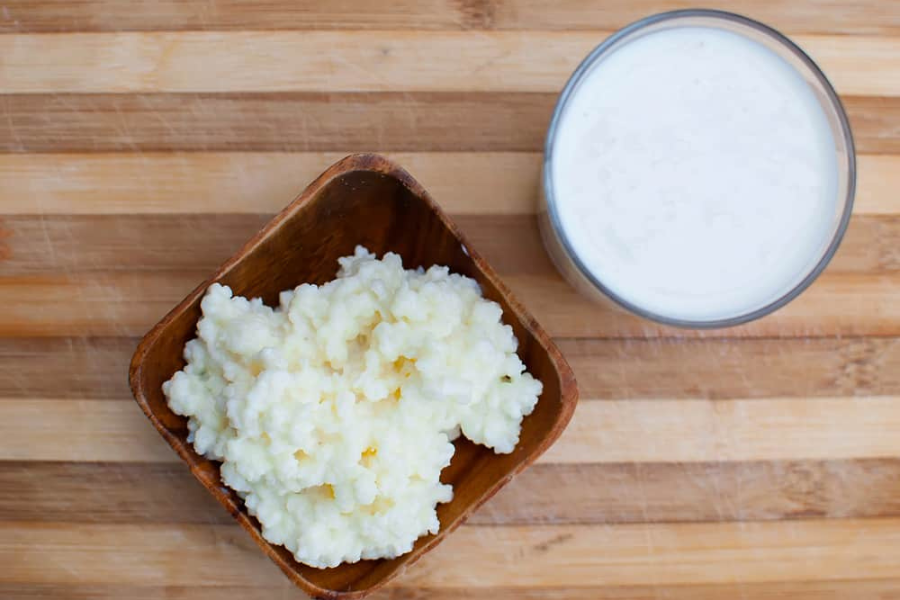
If you're looking for a delicious and easy way to support your health, look no further than homemade kefir. This probiotic-rich fermented drink offers a wide range of benefits that can help you feel your best from the inside out. Here are just a few reasons why you should consider adding kefir to your daily routine:
- Boosts digestive health: Kefir is packed with beneficial probiotics that help to restore balance to your gut microbiome. These friendly bacteria work to break down food, absorb nutrients, and keep harmful microorganisms in check, promoting better digestive health and reducing the risk of issues like bloating, constipation, and diarrhea.
- Strengthens immunity: The diverse array of probiotics found in homemade kefir can also help to strengthen your immune system. By supporting the health of your gut, where a significant portion of your immune system resides, kefir can help your body better defend against harmful pathogens and infections.
- Improves lactose digestion: Many people who are lactose intolerant find that they can enjoy kefir without experiencing digestive discomfort. This is because the milk kefir grains consume much of the lactose during the fermentation process, making the final product lower in lactose and easier to digest.
- Provides essential nutrients: In addition to probiotics, kefir is also a great source of essential vitamins and minerals, including calcium, magnesium, phosphorus, and vitamin K2. These nutrients play crucial roles in maintaining strong bones, supporting cardiovascular health, and promoting overall wellness.
- Versatile and delicious: Homemade kefir is incredibly versatile and can be enjoyed on its own, blended into smoothies, or used as a base for dips, dressings, and even baked goods. Its tangy, slightly effervescent flavor adds a delicious twist to both sweet and savory dishes, making it easy to incorporate into your daily diet.
By making kefir a regular part of your routine, you can enjoy all of these incredible benefits and more. So why not give this probiotic-rich fermented drink a try and see how it can support your health and well-being?
How to Make Goat Milk Kefir?
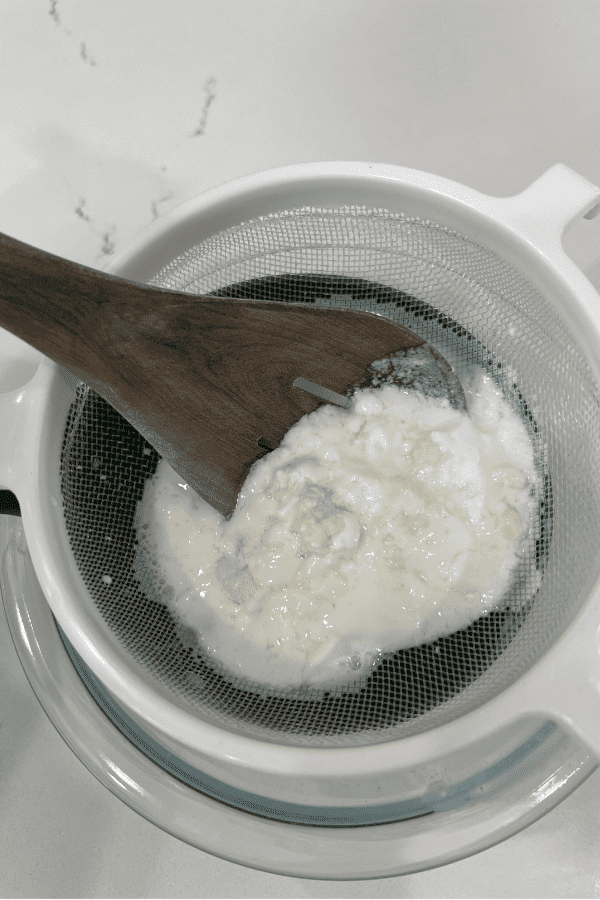
Making your own goat milk kefir at home is a simple and rewarding process that requires just a few ingredients and supplies. By following these step-by-step instructions, you'll be enjoying delicious, probiotic-rich homemade kefir in no time.
Ingredients
- 1 tablespoon of milk kefir grains
- 3-4 cups of goat milk
Supplies
- Glass jar with a tight-fitting lid
- Wooden or plastic spoon (avoid metal as it can react with the kefir grains)
- Cheesecloth or fine-mesh strainer
- Rubber band
Instructions
There are two phases to making goat milk kefir. The first phase is the Reviving Period (which generally lasts 1-3 milk changes), and the second phase is the Active Period (where you will notice more, quicker changes to your milk).
Step 1: Reviving New Kefir Grains
Before you can enjoy the delicious and nutritious benefits of homemade kefir, it's essential to revive your milk kefir grains. This process involves gradually acclimating the grains to their new environment and ensuring they are strong enough to culture milk effectively.
Here's a step-by-step guide to Reviving your kefir grains:
- Begin by placing your milk kefir grains in a clean glass jar with 1-2 cups of fresh goat milk.
- Find a warm spot in your home, ideally between 70°F and 85°F (21°C and 29°C), and allow the mixture to ferment for 36 hours. This extended fermentation time gives the grains a chance to wake up and start consuming the lactose in the milk.
- After 36 hours, strain the mixture using a plastic strainer and discard the milk by-product. It's important to note that this first round of kefir should NOT be consumed.
- Repeat steps 1-3 until you notice the grains are culturing the milk within 24-36 hours. This process typically takes 1-3 rounds and can take up to a week for the grains to regain their full strength.
During the reviving process, keep an eye out for visual changes in the milk, such as clumping around the grains or the separation of whey from the milk. These signs indicate that the grains are becoming more active and are beginning to ferment the milk effectively.
As your kefir grains grow and become stronger, you may need to adjust the ratio of grains to milk. Start with one cup of milk and modify the amount as needed. Remember, the grains thrive on lactose, so as long as you provide them with a steady supply of milk, they will continue to grow and produce delicious kefir.
While the second round of milk may be safe to consume, it might not be to your liking just yet. Trust your senses and use your best judgment before consuming the kefir. As you continue to ferment batches, you'll find the perfect balance of tartness and creaminess that suits your taste preferences.
By following these simple steps and providing your milk kefir grains with a nurturing environment, you'll soon have a thriving culture that will produce delicious, probiotic-rich kefir for you to enjoy.
Step 2: Active Period
During this stage, the steps are similar to the reviving period, but you'll notice that changes in the milk occur more rapidly, which is perfectly normal. You'll observe the milk beginning to gel or thicken, and you may even see pockets of whey appearing – all natural parts of the milk fermentation process.
If you notice any changes or curds sticking to the grains, you're on the right track. And don't be too concerned about the smell of your ferment at the end, as it's expected to have a potent aroma.
- Once your kefir grains are activated, place them in a clean, wide-mouth Mason jar and pour in 3-4 cups of fresh goat milk.
- Cover the jar with a coffee filter or cheesecloth, and let the mixture culture at room temperature on your countertop for 8 to 48 hours.
- Note: The culturing time will depend on the temperature of your kitchen. Warmer temperatures will accelerate the process, so monitor the kefir grains and check the appearance and aroma periodically.When the kefir is ready, set up a funnel and strainer on top of another clean, wide-mouth Mason jar.
- Pour the cultured kefir through the strainer, gently stirring to separate the kefir grains from the liquid.
- Transfer the strained kefir grains to a new jar with fresh goat milk, and cover it with a coffee filter or cheesecloth to begin the next batch.
- Place a lid on the jar containing the strained, cultured goat milk kefir and store it in the refrigerator.
Your homemade goat milk kefir can be enjoyed for up to 2-3 weeks, although it's often consumed much sooner due to its delicious taste and numerous health benefits.
Perfecting Your Kefir
By following these simple steps, you'll be able to create your own probiotic-rich, creamy goat milk kefir at home, ensuring a steady supply of this nutritious fermented drink for you and your family to enjoy.
Once your milk kefir grains have regained their strength, which typically takes about a week, you'll be ready to start making larger batches of kefir. The amount of kefir you can produce each day will depend on your fermentation time and personal preferences, but generally, you can expect to make between two and six cups of kefir per day.
Culturing kefir is all about finding the right balance. The ratio of kefir grains to milk will vary based on factors such as the strength and activity of the grains, as well as the temperature of your fermentation environment. As a general rule, one tablespoon of kefir grains can ferment between 2-6 cups of milk. This wide range means that you'll need to experiment a bit to find the ideal ratio for your specific situation.
When you're first starting out, begin with 1-2 cups of milk. As your grains reactivate, grow, and gain strength, you can gradually scale up the amount of milk you use. Keep in mind that the more grains you start with, the quicker you'll need to increase the volume of milk. Finding the perfect balance may involve a bit of trial and error, but as you become more familiar with how your grains work and develop a sense of your preferred kefir consistency and flavor, the process will become easier.
One important thing to remember is that a slow and steady ferment is better than a quick one. As a golden rule, always use the least amount of grains possible for the quantity of milk you want to ferment. This approach will help ensure that your kefir turns out smooth, creamy, and delicious every time.
If you notice that your kefir is separating, with curds on top and clear whey on the bottom, before the 24-hour mark, it's a sign that you need to adjust your ratio of grains to milk in the next round. Try using fewer grains or increasing the amount of milk. On the other hand, if the milk hasn't been fully cultured by the 36-hour mark, you'll want to use more grains or reduce the amount of milk.
The Wrong Way to Make Goat Milk Kefir
While making goat milk kefir is a relatively simple process, there are a few common mistakes that can lead to less-than-optimal results. By avoiding these pitfalls, you can ensure that your homemade kefir turns out delicious and packed with beneficial probiotics every time.
- Using metal utensils: Kefir grains are sensitive to metal, which can react with the grains and disrupt the fermentation process. Always use wooden or plastic spoons and avoid metal sieves or containers when handling your kefir grains.
- Not using fresh milk: Kefir grains thrive on the natural sugars found in fresh milk. Using milk that is close to its expiration date or has been sitting in the fridge for too long can result in a weaker fermentation and a less flavorful kefir.
- Overfermentation: While it's tempting to leave your kefir to ferment for longer in the hopes of creating a stronger, tangier flavor, overfermentation can actually lead to a yeasty, unpleasant taste. Stick to the recommended 24-48 hour fermentation time and adjust according to your preferences.
- Using too many or too few kefir grains: The ratio of milk kefir grains to milk is important for creating a well-balanced kefir. Using too many grains can lead to a rapid fermentation and an overly sour taste, while using too few can result in a weak, watery kefir.
- Not storing kefir grains properly: If you're taking a break from making kefir, it's important to store your milk kefir grains properly to keep them healthy. Avoid rinsing them with tap water, which can contain chlorine that can harm the grains. Instead, rinse them with cold, filtered water and store them in fresh milk in the refrigerator.
By steering clear of these common mistakes and following the proper techniques for making goat milk kefir, you can ensure that your homemade probiotic-rich fermented drink turns out perfectly every time.
Other Types of Kefir Culture
While milk kefir grains are the most common type of kefir culture, there are several other varieties that can be used to create delicious, probiotic-rich fermented drinks. Each type of kefir culture has its own unique characteristics and can be used with different liquids to create a range of flavors and health benefits.
- Water Kefir Grains: Water kefir grains, also known as tibicos or Japanese water crystals, are a symbiotic culture of bacteria and yeast that feed on sugar water. These grains can be used to ferment sweetened water, juice, or coconut water, creating a refreshing, effervescent drink that's rich in probiotics. Water kefir has a milder flavor than milk kefir and can be flavored with fruits, herbs, or spices.
- Coconut Milk Kefir: Coconut milk kefir is made by fermenting coconut milk with milk kefir grains. This dairy-free alternative is perfect for those who are lactose intolerant or following a vegan diet. Coconut milk kefir has a creamy, slightly tangy flavor and is packed with beneficial probiotics and healthy medium-chain fatty acids.
- Soy Milk Kefir: Soy milk kefir is another dairy-free option that can be made using milk kefir grains. The fermentation process reduces the amount of phytic acid in soy milk, making it easier to digest and allowing for better absorption of nutrients. Soy milk kefir has a slightly nutty, tangy flavor and can be used as a base for smoothies, dressings, and other recipes.
- Kefir Starter Powder: Kefir starter powder is a dehydrated form of kefir culture that can be used to make milk kefir without the need for milk kefir grains. While this method is convenient, it does not allow for the long-term reuse of the culture, as you would with milk kefir grains. Kefir starter powder typically contains a more limited range of probiotic strains compared to milk kefir grains.
By experimenting with different types of kefir cultures, you can discover new and delicious ways to incorporate probiotics into your diet. Whether you prefer the classic taste of goat milk kefir or want to explore dairy-free alternatives like coconut or soy milk kefir, there's a kefir culture out there for everyone.
Conclusion
Making your own goat milk kefir at home is a simple, rewarding, and delicious way to boost your gut health and enjoy the many benefits of this probiotic-rich fermented drink. By following the step-by-step instructions outlined in this tutorial, you can create creamy, tangy, and nutritious kefir using just a few basic ingredients and supplies. Whether you prefer the distinct flavor of goat milk or the milder taste of cow milk, experimenting with different types of kefir cultures and fermentation times will help you find your perfect homemade kefir recipe. As you incorporate this versatile ingredient into your daily routine, you'll discover countless ways to enjoy its health benefits and unique flavor profile. So why not give homemade goat milk kefir a try today? With a little practice and patience, you'll be a kefir-making pro in no time, enjoying all the delicious rewards of this ancient probiotic powerhouse.
Frequently Asked Questions
Ways to Use Kefir
Kefir is a versatile ingredient that can be enjoyed in many ways. Drink it plain as a refreshing, probiotic-rich beverage, or use it as a base for smoothies, blending it with your favorite fruits and vegetables. Kefir also makes a great addition to salad dressings, dips, and spreads, adding a tangy, creamy texture and a boost of probiotics. In baking, kefir can be used in place of buttermilk or yogurt for a moist, flavorful result. Try using kefir as a marinade for meats or vegetables, as the acidity helps to tenderize and add flavor. For a healthy frozen treat, blend kefir with fruit and freeze in popsicle molds.
How Long Does Kefir Last in the Fridge
Homemade kefir can be stored in the refrigerator for up to 1-2 weeks. Keep in mind that kefir will continue to ferment slowly even in the fridge, becoming increasingly tangy and effervescent over time. If you notice any signs of spoilage, such as mold, off-odors, or excessive separation, discard the kefir. To maximize the shelf life of your kefir, store it in a clean, airtight container in the coldest part of your refrigerator.
Is Cow Milk or Goat Milk Better for Making Milk Kefir?
Both cow milk and goat milk can be used to make delicious, probiotic-rich milk kefir. The choice depends on your personal taste preferences and dietary needs. Goat milk kefir has a slightly tangy, more distinct flavor compared to cow milk kefir, which has a milder taste. Some people who are sensitive to cow milk may find goat milk easier to digest due to its smaller fat globules and slightly different protein structure. However, cow milk is more widely available and typically less expensive than goat milk. Experiment with both types of milk to find the one that works best for you.
